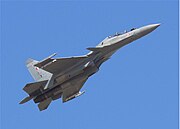Culture
India's culture is marked by a high degree of syncretism[122] and cultural pluralism.[123] It has managed to preserve established traditions while absorbing new customs, traditions, and ideas from invaders and immigrants and spreading its cultural influence to other parts of Asia.
Traditional Indian society is defined by relatively strict social hierarchy. The Indian caste system describes the social stratification and social restrictions in the Indian subcontinent, in which social classes are defined by thousands of endogamous hereditary groups, often termed as jātis or castes.
Traditional Indian family values are highly respected, and multi-generational patriarchal joint families have been the norm, although nuclear family are becoming common in urban areas.[96] An overwhelming majority of Indians have their marriages arranged by their parents and other respected family-members, with the consent of the bride and groom.[124] The marriage is thought to be for life,[124] and the divorce rate is extremely low.[125] Child marriage is still a common practice, with half of women in India marry before the legal age of 18.[126][127]
Indian cuisine is characterized by a wide variety of regional styles and sophisticated use of herbs and spices. The staple foods in the region are rice (especially in the south and the east) and wheat (predominantly in the north).[128] Spices originally native to the Indian subcontinent that are now consumed world wide include black pepper; in contrast, hot chili peppers, popular across India, were introduced by the Portuguese.[129]
Traditional Indian dress varies across the regions in its colours and styles and depends on various factors, including climate. Popular styles of dress include draped garments such as sari for women and dhoti or lungi for men; in addition, stitched clothes such as salwar kameez for women and kurta-pyjama and European-style trousers and shirts for men, are also popular.
Many Indian festivals are religious in origin, although several are celebrated irrespective of caste and creed. Some popular festivals are Diwali, Ganesh Chaturthi, Ugadi, Thai Pongal, Holi, Onam, Vijayadasami, Durga Puja, Eid ul-Fitr, Bakr-Id, Christmas, Buddha Jayanti and Vaisakhi.[130] India has three national holidays. Other sets of holidays, varying between nine and twelve, are officially observed in individual states. Religious practices are an integral part of everyday life and are a very public affair.
Indian architecture is one area that represents the diversity of Indian culture. Much of it, including notable monuments such as the Taj Mahal and other examples of Mughal architecture and South Indian architecture, comprises a blend of ancient and varied local traditions from several parts of the country and abroad. Vernacular architecture also displays notable regional variation.
Indian music covers a wide range of traditions and regional styles. Classical music largely encompasses the two genres – North Indian Hindustani, South Indian Carnatic traditions and their various offshoots in the form of regional folk music. Regionalised forms of popular music include filmi and folk music; the syncretic tradition of the bauls is a well-known form of the latter.

A prayer flag above Tanze Monastery in the Kurgiakh Valley. The wind is believed to propagate the prayers printed on tissue.
Indian dance too has diverse folk and classical forms. Among the well-known folk dances are the bhangra of the Punjab, the bihu of Assam, the chhau of West Bengal, Jharkhand and sambalpuri of Orissa and the ghoomar of Rajasthan. Eight dance forms, many with narrative forms and mythological elements, have been accorded classical dance status by India's National Academy of Music, Dance, and Drama. These are: bharatanatyam of the state of Tamil Nadu, kathak of Uttar Pradesh, kathakali and mohiniyattam of Kerala, kuchipudi of Andhra Pradesh, manipuri of Manipur, odissi of Orissa and the sattriya of Assam.[131]
Theatre in India often incorporates music, dance, and improvised or written dialogue.[132] Often based on Hindu mythology, but also borrowing from medieval romances, and news of social and political events, Indian theatre includes the bhavai of state of Gujarat, the jatra of West Bengal, the nautanki and ramlila of North India, the tamasha of Maharashtra, the burrakatha of Andhra Pradesh, the terukkuttu of Tamil Nadu, and the yakshagana of Karnataka.[133]
The Indian film industry is the largest in the world.[134] Bollywood, based in Mumbai, makes commercial Hindi films and is the most prolific film industry in the world.[135] Established traditions also exist in Bengali, Kannada, Malayalam, Marathi, Tamil, and Telugu language cinemas.[136]
The earliest works of Indian literature were transmitted orally and only later written down.[137] These included works of Sanskrit literature – such as the early Vedas, the epics Mahābhārata and Ramayana, the drama Abhijñānaśākuntalam (The Recognition of Śakuntalā), and poetry such as the Mahākāvya[138] – and the Tamil language Sangam literature.[139] Among Indian writers of the modern era active in Indian languages or English, Rabindranath Tagore won the Nobel Prize in 1913.













